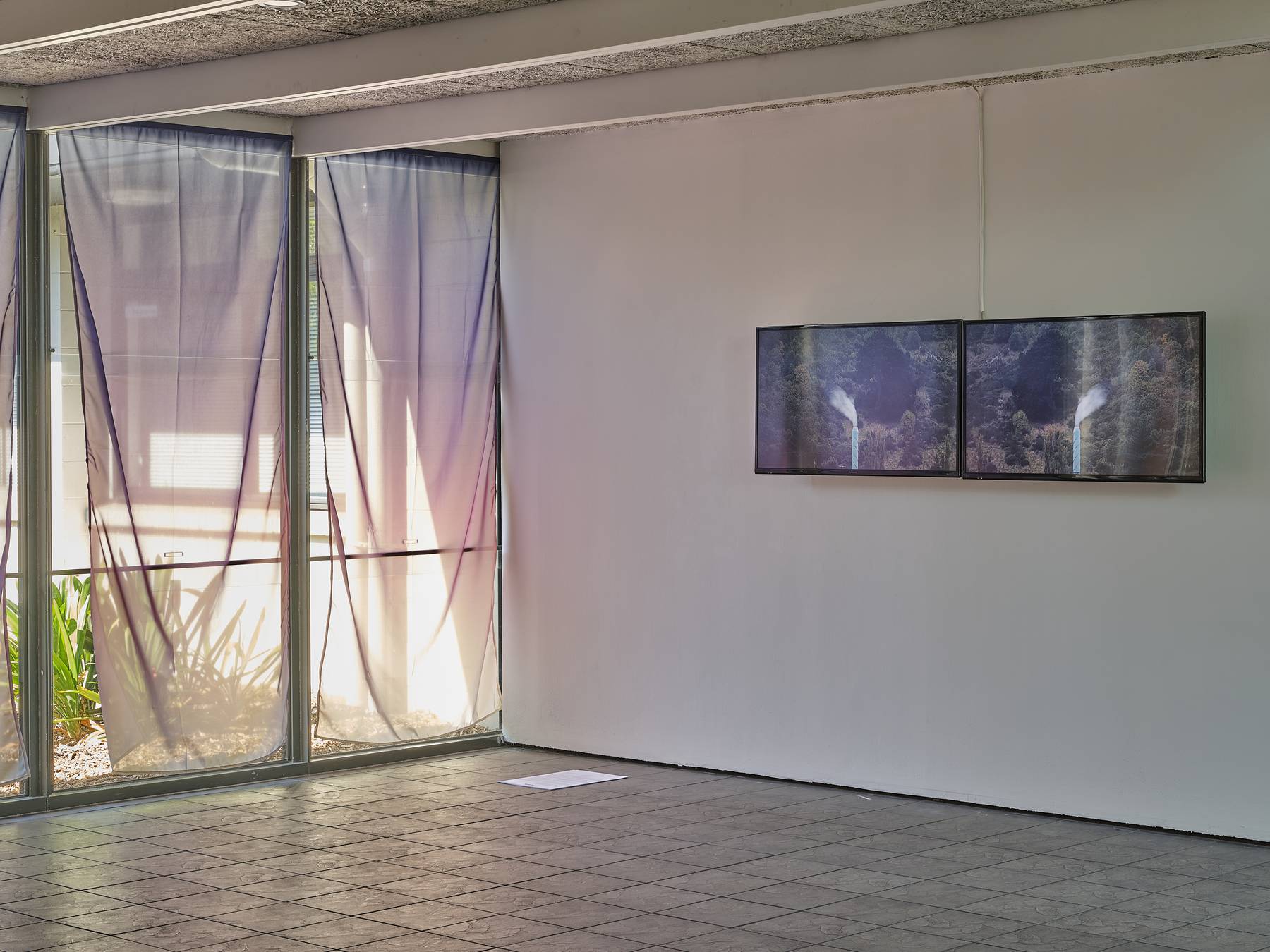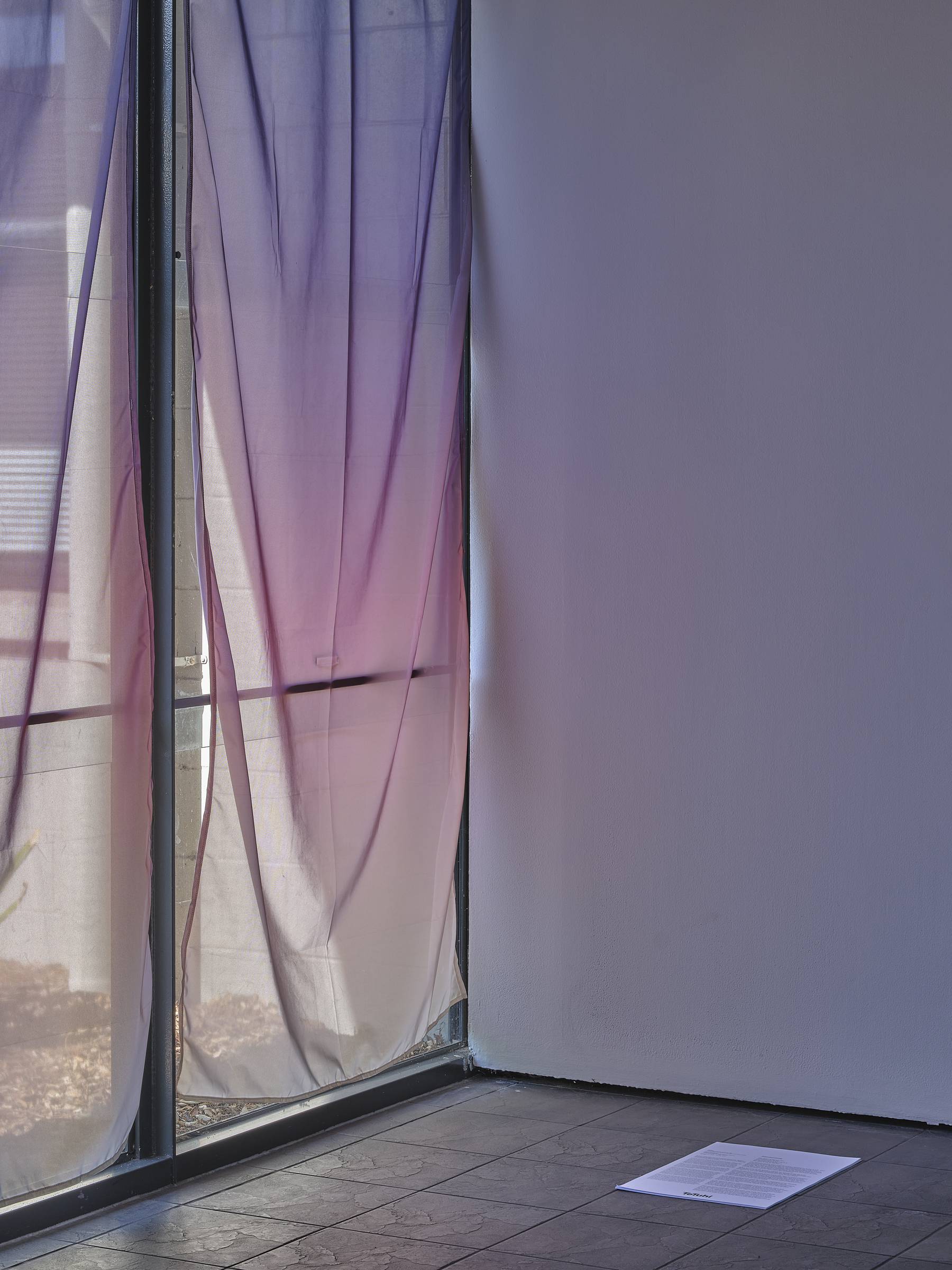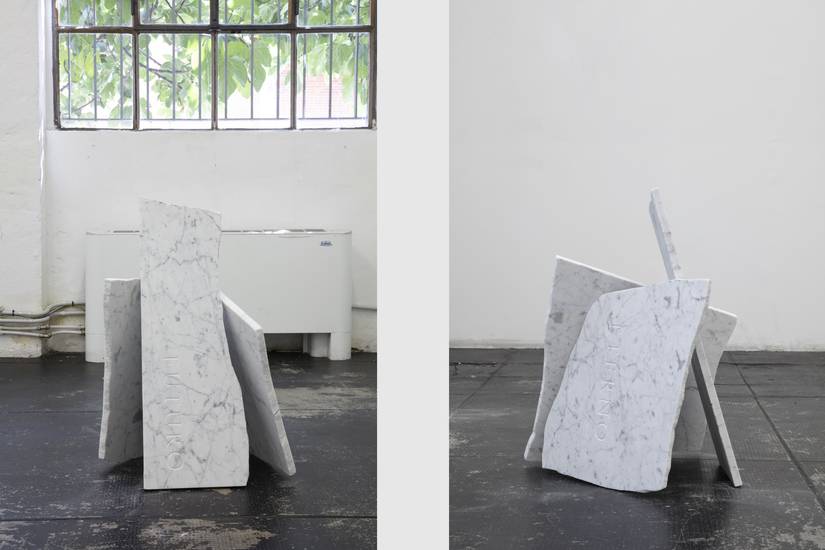Endless.

Te Tuhi’s Project Wall features the pairing of projects by Matthew Galloway and Mohamed Sleiman Labat. In different ways, Endless and Desert Strawberries both shed light on Aotearoa’s reliance on phosphate rock from occupied Western Sahara.
From his house on Otago Harbour in Ōtepoti Dunedin, Galloway sees the same view every evening. Across the water, a plume of smoke rises from the chimney of the Ravensdown Factory as the sun sets. This factory processes phosphate rock into the fertiliser used to make our agriculture industry more productive. However, in order to make this crucial product, Aotearoa is currently reliant on imports of phosphate rock from occupied Western Sahara. By purchasing this rock, we are helping fund Morocco’s brutal occupation of this territory, where those indigenous to Western Sahara are either heavily persecuted within the occupied zone, or live in Algerian refugee camps.
Endless seeks to recreate Galloway’s evening view. Semi-opaque flags are hung over the windows, transforming the transitional space of Te Tuhi’s foyer into a state of permanent dusk, while a looped video shows the chimney stack in a state of endless production. But in this instance the chimney appears again, this time reflected on a second screen. A divergence is created, as the smoke and many gulls gliding on the wind shoot in opposite directions.
Additionally, Galloway has worked with Mohamed Sleiman Labat—a visual artist and poet based in the Sahrawi Refugee Camps—to adapt elements of his film Desert Strawberries into a sound work that fills the Te Tuhi foyer. This work features a recording of Sleiman Labat’s father speaking in Hassanya, dispersing memories of nomadic life in Western Sahara before the Moroccan invasion (1975) amongst contemporary descriptions of the ‘family gardens’ now being grown in the Sahrawi Refugee camps where they live. These gardens are the initiative of Mohamed’s generation, many of whom have studied abroad and returned with new knowledge and techniques, enabling the establishment of vegetable gardens in the arid conditions of the camps. These gardens are giving Sahrawi more agency over food production, and lessening their reliance on food provided through humanitarian aid.
Sleiman Labat and Galloway first met in the Sahrawi Refugee Camps in 2016, and have had an ongoing correspondence in the years since. The chance to present Endless and Desert Strawberries together aims to deepen the dialogue between their respective practices, while also pointing to the entangled nature of their stories. Two forms of food production are presented here, one operating on a global, industrial scale; the other familial and intimate. Together, the state of false permanence at play in this installation aims to question whether our current systems of trade, production and economics—which operate at the cost of the basic human rights of others—are truly inevitable.
Desert Strawberries
The desert is big and vast.
And when you see it.
You think there is nothing in it.
It’s just sand and rocks.
But there is life in the desert.
The Sahrawi people were nomads before colonisation. If one is only used to movement and travelling like us, settling down is not easily done. Sometimes, back in Western Sahara, we would grow wheat after rainfall. But the life of the Sahrawi has always been dominated by goat and camel hearding. We’ve never grown vegetables or fruits, we never even knew about them. Our food came from the cattle we raised, we drank its milk and ate its meat, and we didn’t have any problems.
When we came to the Refugee Camps, we started to eat the food distributed to us through humanitarian aid. Much of this food was very foreign to us, we only became aware of it here in the camps.
Over the last few years some of our youth who have received education have begun to grow different kinds of vegetables. They started to feed their families, and showed others how to start a garden. Family gardens utilise any small pieces of land belonging to a family where they can grow vegetables and eat what they produce. They grow what they can, the gardens are nearby the family. Now people can see something green close to them, and enjoy its taste, and its smell.
In this harsh environment, with the everyday challenges of the Hamada Desert, family gardens can lessen the difficulties faced, creating something beautiful in a harsh environment. People solve their problems using what they can find. Every piece of metal, every stick and rope can support, fasten or hold something. People try to protect their gardens with anything they can.
In the Hamada Desert, people managed to grow tomatoes, onion and pepper, lettuce and cucumber, coriander and mint, basil and fig, and many other fruits we were not aware of before. In Hassanya, we call plants Rebiy, from the word for Spring, perhaps because we used to see a lot of plants when Spring comes. The small green spots in the gardens remind us of the wild plants, and bring back their colours and smells.
There are many challenges and difficulties that make farming difficult in the Refugee Camps; the sun is hot, and the hot wind can burn the plants. But the biggest problem is water scarcity—water is very limited in the Camps, it is distributed by shares amongst the families. In summer, nobody can grow anything, it’s too hot, people just try to survive. People learnt many solutions in the family gardens—dripping irrigation and hydroponics with water scarcity—green houses and shade houses provide shelter for the plants, and animal manure makes good fertiliser, providing the soil with enough organic matter. Family gardens are teaching us many things we didn’t know about. People now talk about soil and seeds; farming seasons, irrigation methods, and ways to protect plants from the elements in such difficult conditions.
The canned food distributed through humanitarian aid here over so many years has caused anaemia and other health issues. Therefore, an alternative has to be thought about in order to improve the food in the Camps. People’s diet has been improving, thanks to the vegetables complementing the meals. It feels really good to eat what you have grown with your own hands—it gives plants a special taste and smell, and you feel you have made something important; you’ve contributed to the growth of people, plants and the soil.
The desert is not just some brown sand; sand particles travel across the seas and oceans. When you see it, it simply looks like some dust falling on plants. But that brown dust is the secret to the greenery. We don’t know how it works, but they say the dust carries phosphorus particles, and it fertilises the forests and plains where it falls. Everything has a role in this life, no matter how small and dusty, even when it feels frustrating at times like this brown sand and the dust particles. It is an important role; one that the trees in the forest are waiting for, as well as the green plains.
They say the desert used to be green in the past.
A green desert now may seem like a mirage.
But it will grow green gradually.
“Drop by drop, the river runs” as the Sahrawi say.
When you sit down next to a plant, it looks motionless and still.
But come back later and you’ll find it bigger.
So, plants also move, they just move slowly, and grow in silence.
Plants are also nomads, they travel upwardly.
Motion and stillness are indeed part of life’s great secrets.
Press→ RNZ Saturday Morning – Matthew Galloway: Why take phosphate from the Western Sahara?


